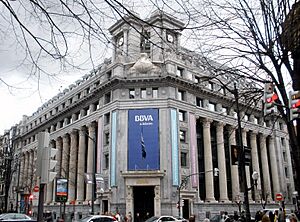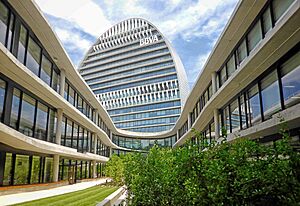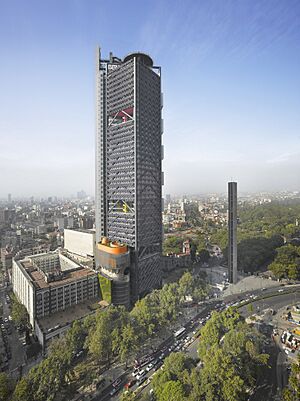Banco Bilbao Vizcaya Argentaria facts for kids
 |
|

BBVA head-office building in Bilbao
|
|
| Sociedad Anónima | |
| Traded as | BMAD: BBVA NYSE: BBVA BMV: BBVA IBEX 35 |
| ISIN | ISIN: [https://isin.toolforge.org/?language=en&isin=ES0113211835 ES0113211835] |
| Industry | Financial services |
| Predecessor |
|
| Founded | Bilbao, Spain 28 May 1857 |
| Headquarters |
Bilbao and Madrid
,
|
|
Key people
|
Carlos Torres Vila (Group Executive Chairman) Onur Genç (CEO) |
| Products |
|
| Revenue | |
|
Operating income
|
|
| Total assets | |
| Total equity | |
|
Number of employees
|
|
BBVA is a very large Spanish company that offers financial services. It is based in Bilbao, Spain, with main offices in Madrid. BBVA is one of the biggest financial groups in the world. It has a strong presence in many countries. These include Spain, Mexico, South America, and Turkey.
The company started as Banco de Bilbao on May 28, 1857. Its main offices are in Madrid, at a place called Ciudad BBVA. It is Spain's second-largest bank. BBVA's shares are traded on major stock exchanges. These include the Madrid Stock Exchange and the New York Stock Exchange.
As of December 31, 2024, BBVA had about €772 billion in assets. This made it the second-largest Spanish financial company. At that time, it had nearly 6,000 offices. It also had over 125,000 employees and 77 million customers. BBVA operates in more than 25 countries. In 2022, The Banker magazine named BBVA the best-performing bank in Spain. The European Central Bank directly supervises BBVA. This is because it is a very important financial institution.
Contents
How BBVA Started and Grew
Early Banks: Banco de Bilbao and Banco de Vizcaya
BBVA's story began in 1857 in Bilbao, a city in northern Spain. A group of business leaders created Banco de Bilbao. It was a bank that helped businesses with loans and payments.
Later, in 1901, Banco de Vizcaya was founded. It also started in Bilbao and slowly grew across Spain. In 1988, Banco de Bilbao and Banco de Vizcaya decided to join together. They officially became one bank, called BBV, in 1989.
Joining Forces: BBV and Argentaria
In 1991, the Spanish government created a public bank called Argentaria. This bank brought together several public banks in Spain. Between 1993 and 1998, Argentaria became a private company.
On October 19, 1999, BBV and Argentaria announced they would merge. This merger created the new bank, BBVA. The goal was to make a bigger, stronger bank. The new BBVA had a solid financial base. It also had a good mix of businesses and risks across different regions. This helped it grow its profits.
Growing in Spain: New Acquisitions

After expanding internationally, BBVA focused on growing in Spain. It wanted to increase its presence in Catalonia. This was a region where it had a smaller market share. Between 2012 and 2014, BBVA bought two financial groups. These were Unnim Banc and Catalunya Banc. Both had been taken over by the Spanish government. They included six savings banks from Catalonia.
In 2020, BBVA talked about merging with Banco Sabadell. This would have created Spain's second-largest domestic bank. However, they could not agree on a price, so the talks ended. In May 2024, BBVA made an offer to buy Sabadell directly from its shareholders. The Spanish government has the power to stop such a merger. In December 2024, BBVA received approval to take control of Sabadell’s businesses in Mexico. In January 2025, BBVA announced plans to buy back some of its own shares. This happened after a restriction on such plans was lifted.
Becoming More Digital
In 2007, BBVA started a big project to become a more digital bank. This meant using more technology for banking services. After these changes, the bank saw more new customers joining each year. By 2015, 14.8 million customers were using digital services.
In 2019, BBVA decided to use one single brand name around the world. This meant that local names like Bancomer in Mexico disappeared. Now, all its banks use the BBVA name. For example, Garanti Bank in Turkey became Garanti BBVA. In January 2021, BBVA announced plans to reduce costs. In February 2021, it was reported that BBVA planned to cut about 3,000 jobs in Spain. This was after its profits dropped in late 2020. In July 2025, BBVA started offering cryptocurrency trading and storage services. This was for regular customers in Spain. It was one of the first traditional banks in Europe to do this.
BBVA Around the World
BBVA started its international journey in 1902. It opened a branch in Paris and then in London in 1918. This made it the first Spanish bank to have offices abroad. In the 1970s, BBVA expanded further. It opened offices in major financial cities in Europe, America, and Asia. The bank also began buying local banks in different countries.
In 2019, the bank changed its name to BBVA everywhere. It stopped using local brand names. For example, in Mexico, it became BBVA México instead of Bancomer. In Turkey, Garanti became Garanti BBVA. In February 2025, BBVA looked for a partner to invest in a large real estate project in Madrid. This project is expected to finish by 2035.
Growth in Latin America
In 1979, Banco de Vizcaya bought a bank in Puerto Rico. This bank later became BBVA Puerto Rico. In 1995, BBVA entered Peru and Mexico. It bought Banco Continental in Peru and Probursa in Mexico. Probursa later merged with BBVA Bancomer. This created a large financial group in Mexico.
In 1996, BBVA expanded into Colombia and Argentina. It bought Banco Ganadero in Colombia and BBVA Francés in Argentina. It also bought more banks in Mexico. In 1997, BBVA entered Venezuela by buying Provincial Bank. It also expanded in Argentina and started a pension fund business in Bolivia.
In 1998, the bank entered Chile and Brazil. In 2000, BBV Probursa and Bancomer merged in Mexico. This created BBVA Bancomer, which became the largest bank in Mexico. In 2004, BBVA bought all the remaining shares of Bancomer. It also bought Hipotecaria Nacional, a company specializing in home loans.

By 2001, BBVA had a single system for all its businesses. The BBVA brand was also used for all its banks in Latin America. In 2004, the banks in Chile and Colombia changed their names to simply BBVA. In 2006, BBVA bought Banco Granahorrar in Colombia. This bank later merged with BBVA Colombia. In 2017, BBVA bought Openpay, a Mexican company that helps with online payments. In July 2018, Scotiabank Chile took control of BBVA Chile. The bank was then renamed Scotiabank Azul.
Expanding in the United States
In 2004, BBVA started to grow in the US market. It bought banks in the southern US, using the strength of its Mexican bank, BBVA Bancomer. It bought Valley Bank in California in 2004. In 2005, it bought Banco Laredo in Texas. In 2006, it bought Texas Regional Bancshares.
In 2007, BBVA bought Alabama Compass Bank in the US. This made its presence stronger. Later, BBVA used one name for all its US banks: "BBVA Compass". In 2009, it bought Guaranty Bank after it faced problems. In 2014, BBVA bought Simple, a US digital banking company. In 2015, it bought Spring Studio, a California company that designs digital experiences. By 2018, BBVA USA was one of the 30 largest banks in the US. In 2020, BBVA USA was sold to PNC Financial Services.
Presence in Turkey
In 2010, BBVA bought 24.9% of Turkiye Garanti Bankasi AS. This was the second-largest bank in Turkey. BBVA agreed to manage the bank together with the Dogus Group. Later, BBVA increased its share to 25.01%. In November 2014, BBVA bought another 14.89% of Garanti bank. This brought its total share to 39.9%.
In February 2017, BBVA bought another 9.95% of Garanti bank. This increased its share to 49.85%. On November 15, 2021, BBVA offered to buy the remaining shares of Garanti bank. By May 2022, BBVA owned 86% of Garanti BBVA.
Starting in Italy
In 2021, BBVA opened its services virtually in Italy.
How BBVA Helps Society
BBVA has several initiatives to help society. In 1932, it created a department to share financial knowledge. In 2010, this became BBVA Research, which studies economic topics.
In 1988, the BBVA Foundation was created. This foundation supports scientific research and cultural projects. It also gives awards, grants, and scholarships to talented people.
In 2007, BBVA started the Microfinance Foundation in Latin America. This non-profit group helps small business owners in difficult situations. In 2021, the OECD recognized this foundation. It was noted for helping development in Latin America. It was also recognized for helping gender equality worldwide.
In March 2022, BBVA launched a plan to teach people about money. This plan aims to help one million people improve their financial skills. It also promotes sustainable development and investing.
Caring for the Planet
BBVA has been involved in sustainability since 2007. It was one of the first banks to participate in a "green bond" project. These bonds help fund environmentally friendly projects.
In 2021, BBVA joined the "Net-Zero Banking Alliance." This group, supported by the United Nations, encourages banks to reduce greenhouse gas emissions. The goal is for their lending and investments to have zero net emissions by 2050.
In March 2022, BBVA invested in "LowerCarbon." This fund helps companies that work on climate change solutions. In July 2022, BBVA joined "Carbonplace." This platform makes it easier for people and companies to buy carbon credits. Carbon credits help balance out carbon emissions. In 2023, the Dow Jones Sustainability Index gave BBVA the highest score in Europe. This was for its sustainability efforts for the fourth year in a row.
BBVA on Stock Markets
IBEX 35
BBVA is part of the IBEX 35. This is a list of the 35 most actively traded stocks in Spain.
Eurostoxx 50
BBVA is also listed on the Eurostoxx 50. This index includes other big banks like Santander Bank and Deutsche Bank.
New York Stock Exchange
BBVA's shares are traded on the New York Stock Exchange in the United States.
Mexican Stock Exchange
BBVA's shares are also traded on the Mexican Stock Exchange.
Emerging Economies
BBVA Research created a group called "Emerging and growth-leading economies" (EAGLEs). These are important emerging markets that are expected to lead global growth. They offer good opportunities for investors.
See also
 In Spanish: BBVA para niños
In Spanish: BBVA para niños
- BBVA Foundation Frontiers of Knowledge Award
- Big Four (Spanish banking)
- List of banks in Spain



